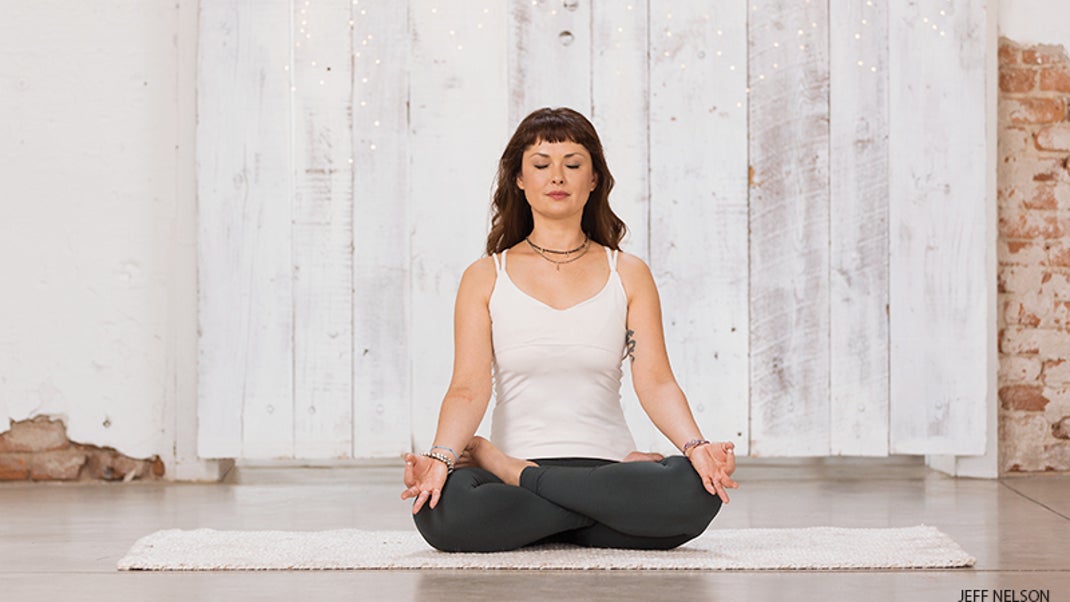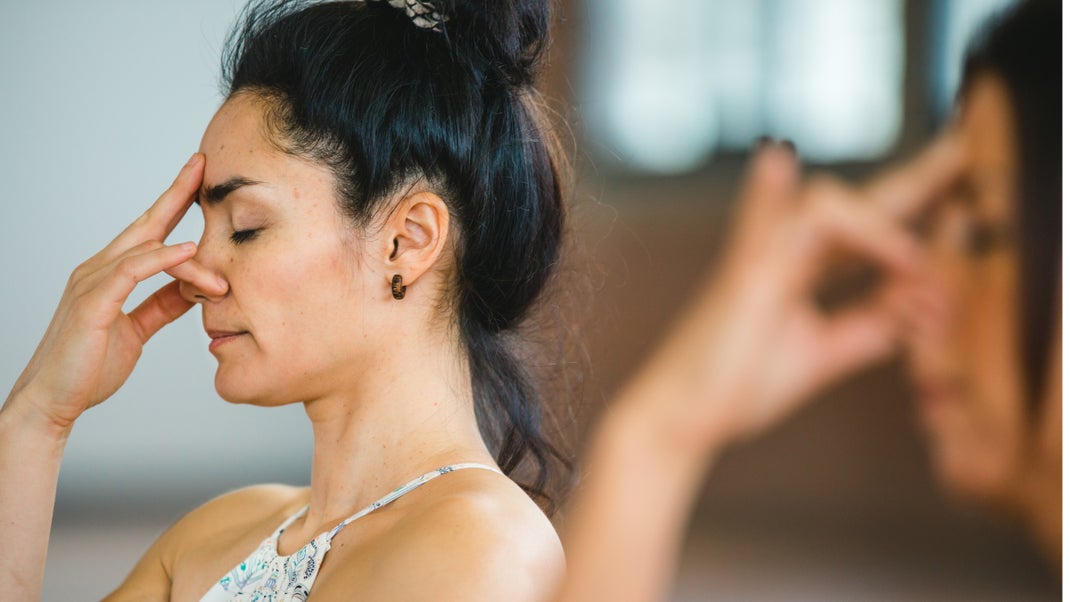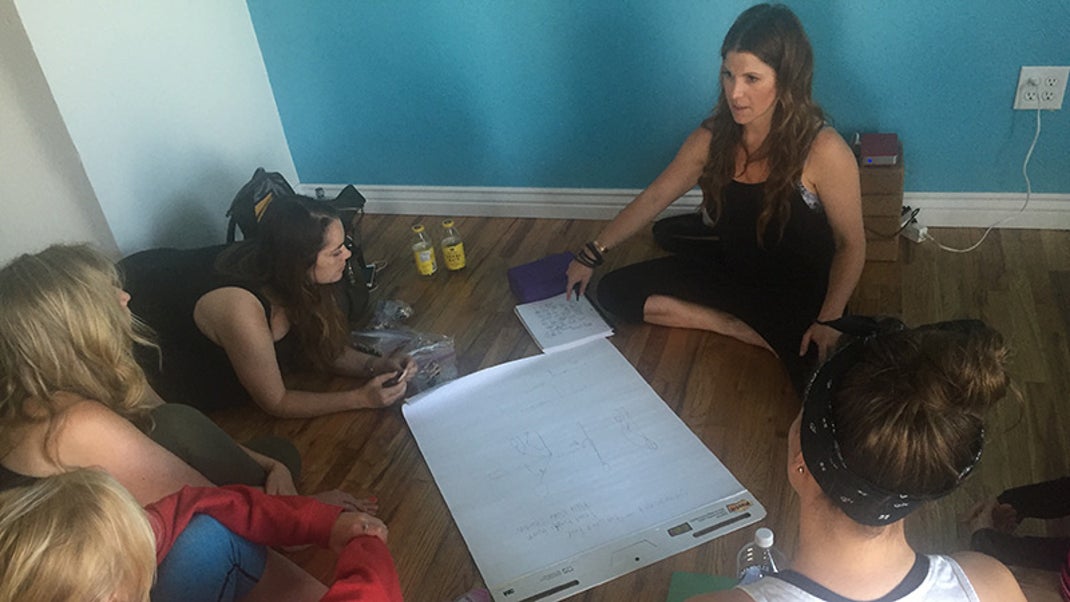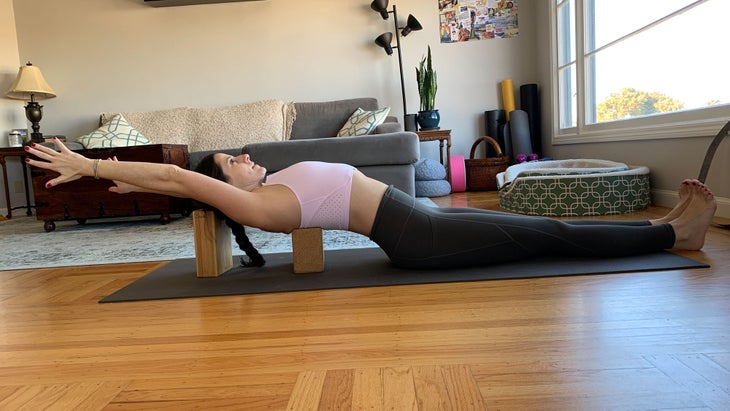Are you feeling stuck? Yoga is a powerful practice that can help with many things including accessing your highest self. Yoga has been used for centuries as a way to reach enlightenment. The word Yoga literally means “union” and it teaches us how to balance the mind, body, and spirit in order to find happiness.
In this blog post, we will discuss one of the most popular Yoga practices- Chakra Yoga. This yoga practice focuses on aligning all seven chakras which are centers within our bodies that correspond with different areas of life – from our physical health, emotional wellbeing, mental clarity, and intuition to our spiritual power and connection with God or higher purpose.
In the following practice, discover each of the seven chakras. By looking at how these energy centers relate to our physical and emotional body, we can shine a light on our deep, dark subconscious—and take steps toward healing ourselves by bringing any unresolved issues to the surface. Here’s what you need to know about the seven chakras and how to work with each in your yoga practice.
How to Use These Practices
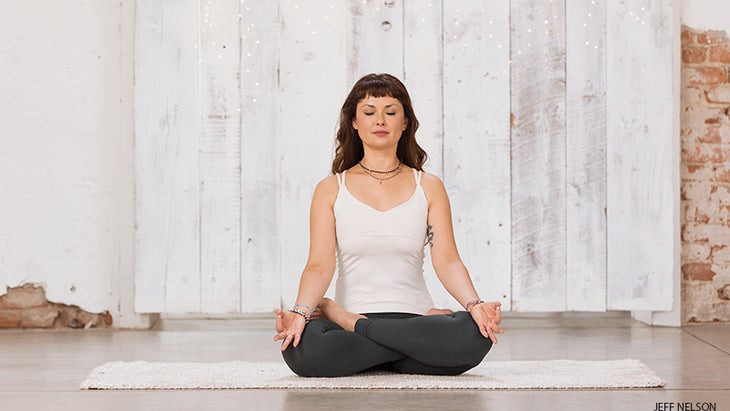 If you’re working on a specific issue, you can go right to the chakra that’ll help you with that issue or you can work through all of the chakras as a sequence, starting with a seated meditation. Here’s how:
If you’re working on a specific issue, you can go right to the chakra that’ll help you with that issue or you can work through all of the chakras as a sequence, starting with a seated meditation. Here’s how:
Journal: Grab your journal and first investigate each chakra as a non-judgmental witness. Notice if you’re able to dive deep or not. Examine your mental and physical threshold and don’t go further than your own capacity. Write down who and what comes up for you as you explore the karmic relationship for each chakra. Allow yourself to feel the range of emotions that may surface and write that down as well.
Practice and Chant: When ready, practice the corresponding pose and chant the bija (seed) mantra aloud for a few breaths, then come out of the pose and note again what’s been revealed. Each mantra is like the passcode to the chakra. Each sound helps awaken our consciousness to what we’ve packed away in the recesses of our body. The mantras combined with the poses help to stimulate a dawning of awareness of what you haven’t addressed.
Muladhara Chakra
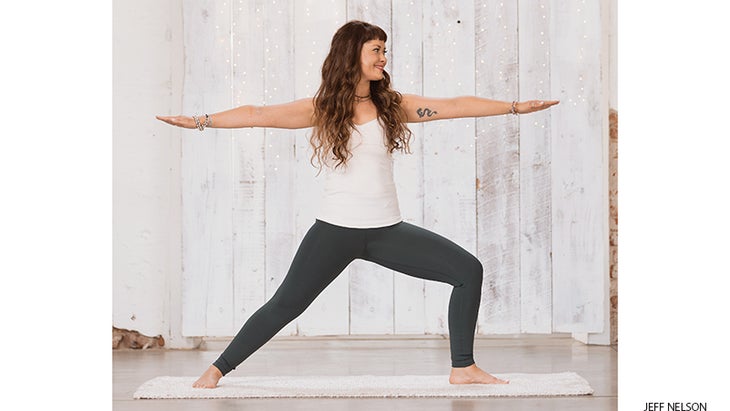 Translation: “Root place”
Translation: “Root place”
Location: Base of your spine, or the coccyx
Related organs: Adrenal glands
Karmic relationship: Mother, father, family, environment, home, workplace, money, job, career
Bija Mantra: LAM
Why: “How your beginnings began determines how you operate in the world,” says Mari. “Working with this chakra can help you see if you are always in survival mode or on guard—and help you move into a more peaceful, balanced state.”
Ask: Did you have stability when you were growing up? What was your financial situation? When you think of your childhood, what comes up?
Pose: Warrior Pose II (Virabhadrasana II)
Stand on your mat with your feet 3 to 4 feet apart, your back foot turned in about 45 degrees, and your front heel in line with your back arch. Raise your arms to shoulder height as you bend the front leg toward a 90-degree angle. As you stretch your hands away from your midline, feel the stability in your legs and feet. Stay here for 8 to 10 breaths, then repeat on the other side.
Svadhisthana Chakra
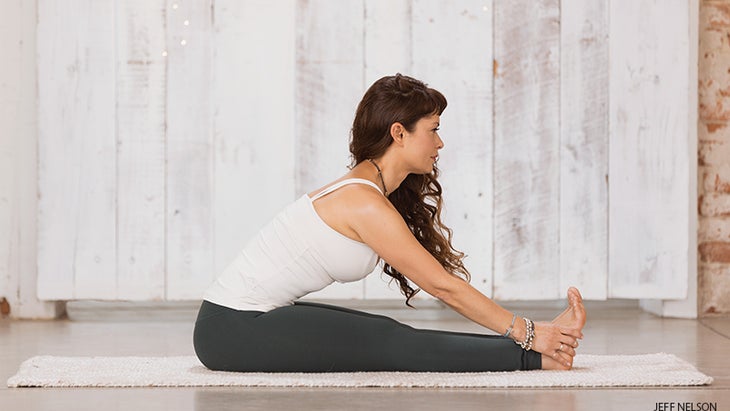 Translation: “Her favorite standing place”
Translation: “Her favorite standing place”
Location: Below the navel, the sacrum
Related organs: Reproductive organs
Karmic relationship: Romantic, sexual, or creative partners, spouses, partners, children
Bija Mantra: VAM
Why: “This area of the body relates to any creative endeavor or partnership, including your sexual relationships,” says Mari. “Forward bends and hip openers offer deep release, which can be particularly helpful when dealing with the resentment, anger, and blame that have a tendency to surface when we work with this chakra.”
Ask: Is there anyone—a current or former sexual partner, or business associate—toward whom you harbor great resentment, anger, or blame? Is there anything inhibiting your ability to be creative?
Pose: Seated Forward Bend (Paschimottanasana)
Sit on the floor with your legs extended in front of you in Dandasana (Staff Pose). Inhale, and keep your torso long, lean forward from your hip joints, lengthening your tailbone away from the back of your pelvis. Hold onto the sides of your feet with your hands, elbows fully extended; if this isn’t possible, loop a strap around your feet. With each inhalation, slightly lift and lengthen your torso; with each exhalation, release a little more fully into the forward bend. Stay in this pose anywhere from 1 to 3 minutes.
Manipura Chakra
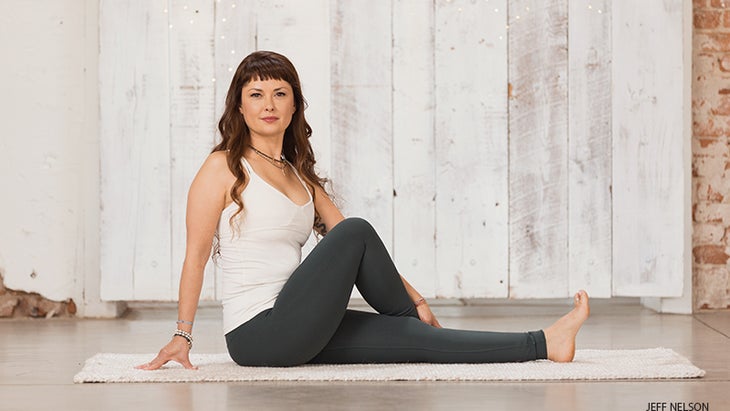 Translation: “Jewel in the city”
Translation: “Jewel in the city”
Location: Solar plexus region, above the navel
Related organs: Stomach, liver, spleen, pancreas, intestines
Karmic relationship: Others you have hurt
Bija Mantra: RAM
Why: An imbalanced solar plexus chakra can manifest as fear, lack of self-confidence, and disempowerment. Who do you disempower in order to feel powerful? The ultimate goal? To feel comfortable with your own inherent power, fully stepping into the ways you as an individual can positively impact the collective without harming others.
Ask: Are there areas of your life in which you feel powerless? If so, how does this manifest? Who do you disempower in order to feel more powerful yourself?
Pose: Half Lord of the Fishes Pose, variation (Ardha Matsyendrasana)
Sit on the floor with your legs extended in front of you in a Staff Pose. Bend your right leg and place your right foot outside your left hip. Press the right hand against the floor just behind your right sitting bone, and set your left elbow on the outside of your right thigh near the knee. On an exhale, twist toward the inside of the right thigh. Press the inner right foot into the mat as you lengthen your torso. With every inhalation, lift a little more through the sternum; with every exhalation, twist a little deeper. Stay for 30 seconds to 1 minute, then release with an exhalation, return to the starting position, and repeat on the other side.
Anahata Chakra
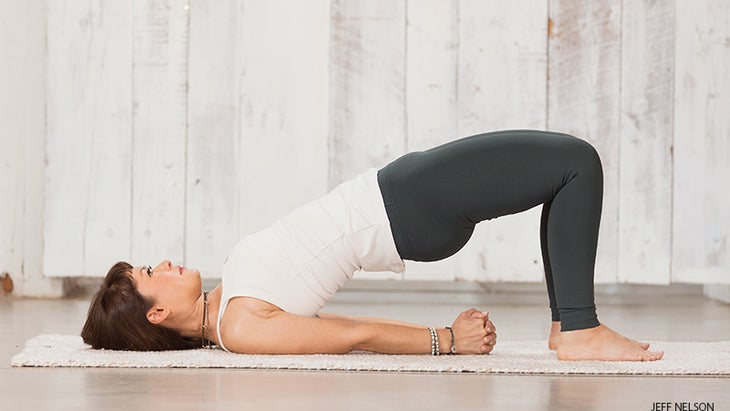 Translation: “Unstruck”
Translation: “Unstruck”
Location: Center of the chest
Related organs: Heart, thymus
Karmic relationship: Others who have hurt you
Bija Mantra: YAM
Why: When most yogis think of the heart chakra, they assume “opening” it is the goal. And while heart-opening poses can remind practitioners of the compassion and joy that’s inherent in them, Mari says it can be just as beneficial to see this chakra as a bridge between the lower and upper chakras. “It’s how we integrate the manifest with the spiritual,” she says. “It’s how we feel self-compassion and unconditional love toward ourselves, and then share it with others.”
Ask: What are the ways in which my pain or fear of being hurt by others has shut me down?
Pose: Bridge Pose (Setu Bandha Sarvangasana)
Lie on your back, bend your knees, and bring your heels toward your sitting bones. Then, press your feet into the mat and lift your pelvis toward the ceiling. Tuck your shoulders underneath themselves and rotate your palms so they face upward; you can also interlace your fingers underneath your pelvis. Press your upper arms and feet into the mat, isometrically squeeze your thighs toward one another, and lengthen your tailbone toward your knees while keeping your chin off your chest. Hold here for 5 breaths, and then lower back to your mat from shoulders to hips. Rest for 2 breaths, and then repeat 2 more times.
Vishuddha Chakra
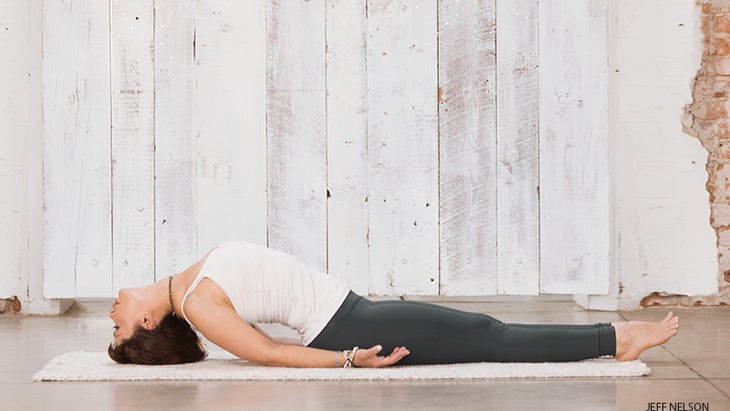 Translation: “Pure”
Translation: “Pure”
Location: Throat at the base of the neck
Related organs: Thyroid gland, vocal cords, ears, skin
Karmic relationship: How you see yourself
Bija Mantra: HAM
Why: How we speak and what we speak is a representation of the mind. The quality of our mind determines how we see ourselves in the world.
Ask: What do you say to yourself? Do you see yourself as capable of being enlightened? Do you believe you are worth it or is your internal dialogue limiting and negative?
Pose: Fish Pose (Matsyasana)
Lie on your back with your knees bent, feet on the floor. As you inhale, lift your pelvis slightly off the floor, and slide your hands, palms down, below your sitting bones; rest your buttocks on the backs of your hands. Keeping your forearms and elbows close to your torso and pressing firmly against the floor, inhale and lift your head and upper torso away from your mat. Then, release your head back onto the floor and straighten your legs if you can. Stay here for 15 to 30 seconds, breathing smoothly. To come out, on an exhale lower your torso and the back of your head to the floor, then draw your thighs up into your belly and squeeze your legs into your chest.
Ajna Chakra
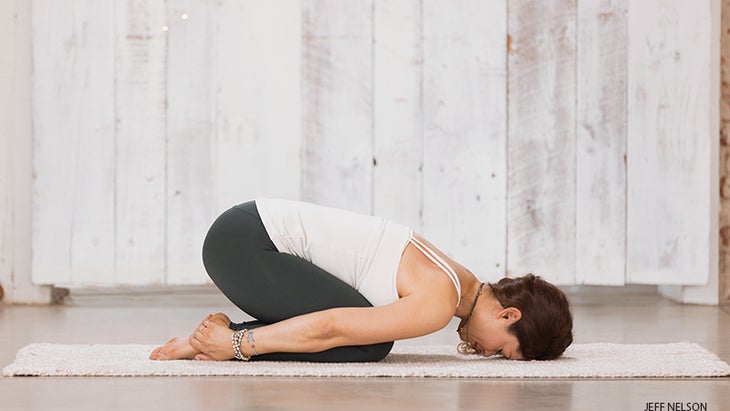 Translation: “Command center”
Translation: “Command center”
Location: Between your eyebrows in the deep interior of the brain
Related organ: Pineal gland
Karmic relationship: Guru and teachers
Bija Mantra: OM
Why: Commonly known as the home of the third eye, this chakra and its asana is associated with humility. Bowing to one’s teacher both inside and out. However, both are the same. The teachers we have in our lives that come in the form of parents, spiritual teachers, and the like, are simply us outside of ourselves. We often think a teacher is one we love and adore, but sometimes the best teachers really give us the business.
Ask: Who is your guru? What are they here to teach you? Who pushes your buttons? Who simultaneously loves you and kicks your butt?
Pose: Child’s Pose (Balasana)
Sahasrara Chakra
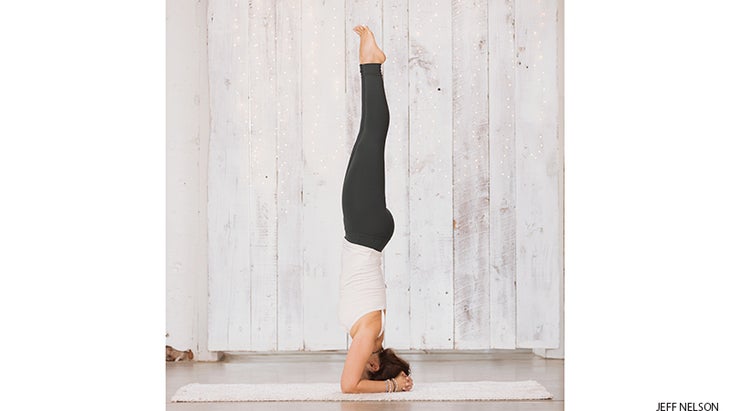 Translation: “Thousand-petaled lotus”
Translation: “Thousand-petaled lotus”
Location: Hovering above your head
Related organ: Pituitary gland
Karmic relationship: God, the Divine
Bija Mantra: Internalized OM
Why: Sahasrara means “thousand-petaled” and represents a thousand-petaled lotus flower thought to reside just above the crown of your head, says Mari. “This chakra is the gateway to enlightenment—the place where it is no longer possible to experience yourself as separate from anyone or anything,” she adds.
Ask: Who or what represents that which is beyond my ego-self? Do I believe in a divine aspect, a personal form of the Divine that you can relate to? Is it G.O.D? (give own definition)?
Pose: Supported Headstand (Salamba Sirsasana)
From Tabletop, interlace your fingers and set your forearms on the floor, elbows at shoulder width. Roll your upper arms slightly outward and press your inner wrists firmly into the floor, then set the crown of your head on your mat. Come off your knees and onto your toes, carefully walking your feet closer to your elbows. Exhale and lift your feet away from the floor, taking both feet up at the same time, even if it means bending your knees. As the legs (or thighs, if your knees are bent) rise to perpendicular to the floor, turn your upper thighs slightly inward and press your feet actively toward the sky. Do this pose close to a wall at first, which will keep you safe should you’re your balance. Also, keep in mind that very little weight should actually be placed on your head; use the strength in your arms, shoulders, and core to lift up through your toes, almost as if you could lift your head off the ground. Stay in Supported Headstand for 10 seconds or longer.
Savasana Chakra Meditation
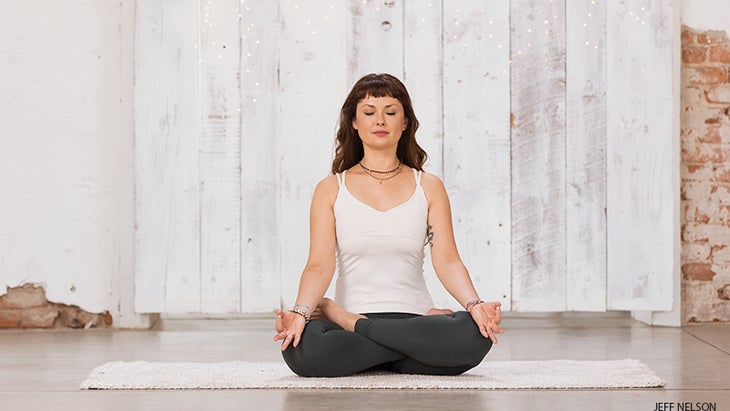 Transition into Savasana. As you lay still, breathe in from the souls of your feet up to the first chakra and chant LAM (vibrating and resonating the “M” for each bija mantra). Inhale again from the feet up the legs to the second chakra and chant VAM. Keep doing this until you’ve completed every chakra. Once you’ve done that remain in your restful state for up to 10 minutes. Slowly sit up in a meditative seat and through means of your breath, begin to re-ground your energy if needed. Inhale and on your exhale starting at the crown chakra observe the energy shifting down. Do this systematically with each chakra. Reside in meditation until you feel tuned and rebalanced. May this practice give you insight, healing, and wellness.
Transition into Savasana. As you lay still, breathe in from the souls of your feet up to the first chakra and chant LAM (vibrating and resonating the “M” for each bija mantra). Inhale again from the feet up the legs to the second chakra and chant VAM. Keep doing this until you’ve completed every chakra. Once you’ve done that remain in your restful state for up to 10 minutes. Slowly sit up in a meditative seat and through means of your breath, begin to re-ground your energy if needed. Inhale and on your exhale starting at the crown chakra observe the energy shifting down. Do this systematically with each chakra. Reside in meditation until you feel tuned and rebalanced. May this practice give you insight, healing, and wellness.
About Our Expert
Based in the San Francisco Bay Area, teacher and model Giselle Mari presents at yoga studios, conferences, and festivals around the world. She has trained with Sharon Gannon, David Life, Sarah Powers, Jai Attal, and Panorama, to name a few. Her teaching style has spunk, spirit, and depth. Her light-hearted but comprehensive teaching style weaves yogic philosophy, Sanskrit, anatomy, skillful hands-on assists, funky eclectic music, and unabashed authenticity into her classes. Her offerings are not only designed to make you move, sweat, reflect, and elevate but to ignite and restore the connection to your essence, inspire spiritual activation, and connect to the power of our humanity. She’s a teacher on YogaGlo, a mom, and a wife with 4 dogs and 2 frogs.
Conclusion:
Yoga is a great way to align your chakras and learn more about yourself. Yoga also has many benefits for both the body and mind. Yoga can help you become happier, healthier (mentally and physically), calmer, stronger, etc.
